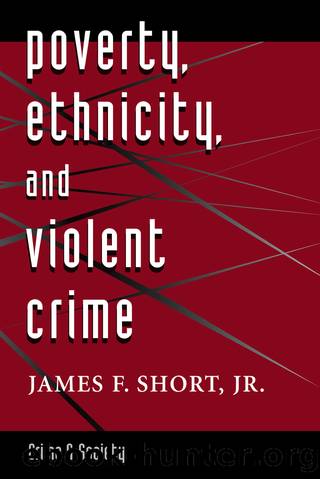Poverty, Ethnicity, And Violent Crime by James F. Short Jr

Author:James F. Short, Jr. [James F. Short, Jr.]
Language: eng
Format: epub
ISBN: 9780429977749
Barnesnoble:
Publisher: Taylor & Francis
Published: 2018-02-19T00:00:00+00:00
Conclusion
The importance of local community cultures, relationships, and situations for understanding and controlling violent behavior can hardly be overestimated. It is at this level that macro-, individual, and micro-levels of explanation converge. Although important clues exist in the research literature reviewed in these chapters, the precise processes that result in interpersonal violence, gang violence, and violence that takes place among large gatherings of (mainly) young people remain a mystery, and must become a high priority for future research. Among these clues, the interaction of macrosocial factors and social capital seems most promising. When social capital is weakened by demographic and economic shifts that concentrate poverty and destabilize community institutions, conventional socialization and control processes fail. When intergenerational relationships break down or are distorted by such developments, the likelihood that gangs will emerge and flourish, and compete with one another, often with deadly consequences, is enhanced.
Social capital is weakened, also, when the legitimacy of the authority of institutions and the adults that are identified with them is weakened. This often happens, Schwartz observes, when authority is perceived by young people as irrational, unreasonable, or both. "To be reasonable, authority must be exercised in ways that respect the dignity of those subject to it" (Schwartz 1987, p. 29). Schwartz identifies "two modalities of authority that many youths experience as illegitimate. The first is authority that intentionally puts them in a humiliating position. . . . The second modality concerns what youth experience as an arbitrary intrusion into their own affairs or as excessive coercion. Adults often have very different ideas than youths about what sorts of behaviors or activities the former can legitimately regulate and control. . . . To be rational, authority must be a means to those ends that are meaningful to persons subject to it. . . . Young people rarely directly challenge the legitimacy of instrumental rationality . . . American youth, from the most affluent to the most deprived, want to get a job and make money" (p. 30).
Social capital clearly involves reciprocal macro-and individual-level influences. That is, communities, families, and other groups and organizationsâand larger social systems such as economies and political systemsâprovide settings within which individuals are socialized and live out their lives. It is in such settings that social capital is produced. Although settings of intimacyâwhat sociologists call primary groupsâare the most immediate shapers of social capital, larger forces of economic, political and other institutions and organizations provide and limit opportunities for its expression and influence social (and human) capital in a multitude of ways. Individual members of families and other groups and organizations, in turn, shape the organizations and institutions in which they participate.
Additionally, although microsocial processes reflect, in part, both the macrolevel settings and qualities of interacting individuals that produce them, members of unsupervised youth groups are especially vulnerable to such processes in the production of violence. Gang and nongang environments differ not so much in norms and values; rather, "different types of situations generated in different social milieus . . . provide the grounds for expressing" norms and values (Sanders 1994, p.
Download
This site does not store any files on its server. We only index and link to content provided by other sites. Please contact the content providers to delete copyright contents if any and email us, we'll remove relevant links or contents immediately.
The 1921 Tulsa Race Massacre by Chris M. Messer(288)
Introduction to Criminal Justice - A Balanced Approach by Brian K. Payne Willard M. Oliver Nancy E. Marion(255)
Punishing the Poor The Neoliberal Government of Social Insecurity by Unknown(250)
Russia's Sakhalin Penal Colony, 1849â1917 by Andrew A. Gentes(249)
The History of Newgate Prison by Jowett Caroline;(236)
Serial Killers America and UK - 2 BOOKS IN 1 by Clark Matthew(211)
A History of Police and Masculinities, 1700-2010 by David G. Barrie Susan Broomhall(197)
Restorative Justice in Transitional Settings by Kerry Clamp(169)
Organized Crime and Corruption Across Borders by T. Wing Lo Dina Siegel Sharon I Kwok(159)
Culture, Crime and Punishment by Ronald Kramer(156)
Dangerousness, Risk and the Governance of Serious Sexual and Violent Offenders by Karen Harrison(156)
Cops, Cameras, and Crisis by Michael D. White Aili Malm(154)
Policing Gender, Class And Family In Britain, 1800-1945 by Linda Mahood(153)
Routledge Handbook on Immigration and Crime by Holly Ventura Miller Anthony Peguero(152)
The Real CSI by Kate Bendelow(150)
Women Exiting Prison by Bree Carlton Marie Segrave(144)
Losing Legitimacy by Gary Lafree(139)
Using Murder by Philip Jenkins(138)
A Theory of African American Offending by James D. Unnever Shaun L. Gabbidon(136)
